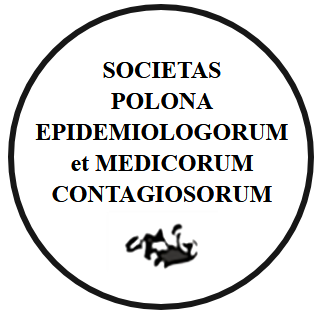ABSTRACT
OBJECTIVE OF THE WORK. The article contains an overview of epidemiological surveillance data on infectious diseases in Poland in 2017 with reference to data from 2016 and median from 2011-2015. This is another introductory article to the systematically conducted Epidemiological Chronicle of Epidemiological Review presenting the current epidemiological situation of selected infectious diseases. In justified cases, eg by cross-border threats, the study includes references to the epidemiological situation in other countries.
MATERIAL AND METHODS. The source data for this study are the applications of doctors to the State Sanitary Inspection, which in the form of summary lists or individual notifications are forwarded to the Department of Epidemiology of Infectious Diseases and Surveillance of NIPH-PZH and after being prepared they are included in the bulletins “Infectious diseases and poisoning in Poland in 2017 “and” Protective vaccinations in Poland in 2017“.
Data on deaths due to infectious diseases come from a list of the Department of Demographic and Labor Market Research of the Central Statistical Office.
RESULTS AND THEIR DISCUSSION. Discussion of epidemiological data begins with the most prevalent diseases in Poland, which are upper respiratory tract infections and gastrointestinal infections. In the area of upper respiratory tract infections, attention is drawn to the increase in the number of reported cases in recent years, which may be at least partly related to the development of computerization of reports. The profile of gastrointestinal infections acquired in the non-hospital environment has been changing in recent years towards a clear predominance of infections with viral etiology in relation to bacterial infections. Regarding healthcareassociated infections, rotavirus infections predominate among children, and among adults, C. difficile infections constitute a serious, growing problem, which is largely associated with the use of antibiotics.
Viral liver infections are still an important problem. B and C, and in 2017 also hepatitis A, which took the form of an epidemic.
In other groups of diseases, there was no clear increase in threats compared to previous years.
Despite a steady decline in incidence, tuberculosis has been the disease causing the highest number of deaths among infectious diseases for many years. In 2017, the highest number of deaths was caused by C. difficile infection.
STRESZCZENIE
CEL PRACY. Artykuł zawiera przegląd danych z nadzoru epidemiologicznego na temat chorób zakaźnych w Polsce w 2017 r. w odniesieniu do danych z 2016 r. i mediany z lat 2011-2015. Jest to kolejny artykuł wprowadzający do systematycznie prowadzonej Kroniki epidemiologicznej Przeglądu Epidemiologicznego przedstawiający aktualną sytuację epidemiologiczną wybranych chorób zakaźnych. W uzasadnionych przypadkach, np. przy zagrożenich transgranicznych, artykuł zawiera odniesienia do sytuacji epidemiologicznej w innych krajach.
MATERIAŁ I METODY. Dane źródłowe do tego badania to raporty lekarzy do Państwowej Inspekcji Sanitarnej, które następnie, w formie zestawień zbiorczych lub indywidualnych powiadomień, przekazywane są do Zakładu Epidemiologii Chorób Zakaźnych i Nadzoru NIPH-PZH, a po przygotowaniu są włączone do biuletynów „Choroby zakaźne i zatrucia w Polsce w 2017 r.” oraz „Szczepienia ochronne w Polsce w 2017 r.”
Dane dotyczące zgonów z powodu chorób zakaźnych pochodzą z listy Departamentu Badań Demograficznych i Rynku Pracy Głównego Urzędu Statystycznego.
WYNIKI I ICH OMÓWIENIE. Omówienie danych epidemiologicznych rozpoczyna się od najbardziej rozpowszechnionych chorób w Polsce, którymi są infekcje górnych dróg oddechowych i infekcje żołądkowo-jelitowe.
W obszarze zakażeń górnych dróg oddechowych zwraca uwagę wzrost liczby zgłaszanych przypadków w ostatnich latach, co może być przynajmniej częściowo związane z rozwojem komputeryzacji raportów. Profil zakażeń przewodu pokarmowego nabytych w środowisku pozaszpitalnym zmienia się w ostatnich latach w kierunku wyraźnej przewagi zakażeń o etiologii wirusowej w porównaniu z zakażeniami bakteryjnymi. W odniesieniu do zakażeń związanych z opieką zdrowotną wśród dzieci dominują zakażenia rotawirusem, a wśród dorosłych zakażenia C. difficile stanowią poważny, narastający problem, który jest w dużej mierze związany ze stosowaniem antybiotyków.
Wirusowe zapalenia wątroby typu B i C są nadal ważnym problemem, a w 2017 r. dotyczy to również zapalenia wątroby typu A, które przybrało formę epidemii.
W innych grupach chorób nie było wyraźnego wzrostu zagrożeń w porównaniu z poprzednimi latami.
Mimo stałego spadku zachorowalności, gruźlica od wielu lat była chorobą powodującą największą liczbę zgonów wśród chorób zakaźnych. W 2017 r. największą liczbę zgonów spowodowało zakażenie C. difficile.
Możesz zmienić ustawienia cookies w swojej przeglądarce. Ograniczenie stosowania plików cookies w konfiguracji przeglądarki może wpłynąć na niektóre funkcjonalności dostępne na stronie.





